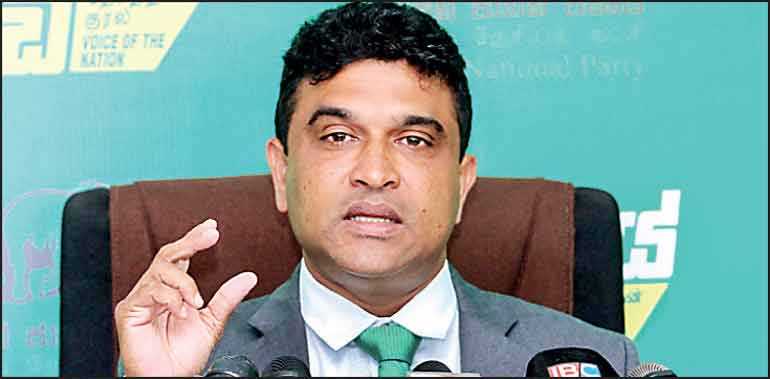Monday Dec 08, 2025
Monday Dec 08, 2025
Wednesday, 27 March 2019 00:00 - - {{hitsCtrl.values.hits}}

By Nuwan Senarathna
Launching a staunch defence of the $3.8 billion refinery that was inaugurated in Hambantota over the weekend, the Government yesterday insisted that its investors were credible and that the project was a validation of the economic programs implemented since 2015. Development Strategies and International Trade Deputy Minister Nalin Bandara insisted the investors were dependable and dismissed concerns raised on transparency, due process and possible environmental damage. Despite the denials, Bandara acknowledged that an Environmental Impact Assessment (EIA) would take as much as six months to complete, but contended it was not necessary, for current construction would only be for the tank farm and the refinery would be built later.
The refinery project commenced on Sunday, and was billed as the largest Foreign Direct Investment (FDI) ever to be received by Sri Lanka. The India based Accord Group is the main investor in the refinery project through a Singapore-registered shell company called Silver Park.
“This investment has proven the Government was able to boost the confidence among investors around the world. The Government had to work hard during the last four years to create an investment-friendly environment in the country,” Bandara told reporters at Sirikotha, the United National Party (UNP) head office in Pita Kotte.
He noted the Government was able to introduce tax policies to stabilise the economy and establish an investment-friendly governing system, which also preserved the democratic values of the country. Bandara pointed out that the Government was able to ensure the freedom of the country and enable all communities in the country to live prosperously.
Bandara said Free Trade Agreements (FTA) play an expanding role to attract investors into the country. He noted FTAs such as the Singapore-Sri Lanka Free Trade Agreement (SLSFTA) had paved the way for the oil refinery project. He also said the FTA had boosted the confidence among investors as such agreements could be used as a channel to establish a business in Sri Lanka more conveniently than other countries in the region.
“It was an Indian investor who invested in Hambantota coming through Singapore. This type of investment helped Singapore to become one the most developed countries in the world,” he argued.
Comparing the current Government and the previous Government, Bandara contended the previous Government led by Opposition Leader Mahinda Rajapaksa was unable to create an investment-friendly environment in the country, and consequently failed to attract investment into the country. He claimed that prior to 2015, Sri Lanka had no economic policies and due to irregularities in the governing system adopted by Rajapaksa, dented the reputation of the country at international level.
“During Rajapaksa’s time, a request for proposals for Mirijjawila Export Processing Zone was called a couple of times, but no one was interested in it due to the situation that prevailed at that time, which was not friendly for investors.”
However, Opposition Leader Mahinda Rajapaksa, and the United People’s Freedom Alliance (UPFA) MPs who back him, had raised the concern in and out of Parliament over the environmental feasibility of the refinery project, and argued it was impractical to supply bunkering services to the Hambantota port.
Opposition Leader Rajapaksa said on Sunday that the refinery project would have a negative impact on the salt production and nearby Bundala bird sanctuary, and MP Namal Rajapaksa had also criticised the project in Parliament on Monday, questioning why the environmental feasibility report was not issued for the refinery project.
Responding to the Opposition’s criticism, Bandara acknowledged the environmental feasibility report was not issued for the refinery project. He argued the environmental feasibility report was not needed for projects that commence inside a zone, as Environment Impact Assessment (EIA) had already been obtained when the zone was demarcated. However, Bandara acknowledged the EIA would not be sufficient for the refinery project, and therefore a separate environment feasibility study would be needed.